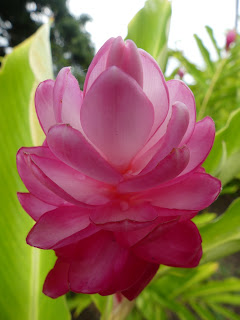We drank quite a bit of coffee this morning and enjoyed a "private tour" at UCC. Learned a lot, e.g. that the coffee "cherries" are ripening gradually July to December and are hand-picked when turning bright red. The berries on the pic below are still green and unripe. Also, coffee plants bloom continuously from January to June. The plants are cut down every couple of years to keep them small and manageable. Branches are very flexible and can be bent down. They only bloom and have fruit on the newly grown parts of the branches. Steep slopes prevent picking by machines, as they do in Kauai with flat huge plantations. However, on Kauai, it's rather mass production and much cheaper and less high-quality produce. The pulp from the cherries (with the beans inside) is used as compost, and the skins are sometimes used similar to tea leaves.


 t
t At Mauka Meadows visitors first walk through a lush botanical garden with a variety of plants - ginger, fruit and nut trees (like the starfruit tree on the pic), pineapples and other ornamental plants - as well as a variety of birds (like the gold finch on the photo). Paradise on earth! On the most prominent point was a pavilion offering great views towards the ocean. Sitting there, we watched a colorful little lizard on the ceiling, high up. The path leads to another open area, where coffee can be tasted and is sold packaged, with an infiniti pool in front and a sitting area.




It was pleasantly warm again, 85 deg. during the day, but cooling down at night. Even during the day always some clouds and a light breeze. Drives were rather short today, just a constant up and down on rather small, windy roads.
Then back to the roots: archeology at Kaloko-Honokohau National Historical Park, down at sea level. This old settlement of the Native Hawaiians is especially worth seeing because of the thoughtful construction of fish ponds (pic below) and fish traps and interesting petroglyphs. A canoe house (pic) is reconstructed at the beach in addition, to show how these settlers from Tahiti, who came in the 13th century, lived. On the trail down to the ocean we noticed some monumental breadfruit trees (pic), formerly an important part of nutrition. The flat ocean, where remains of the fish traps are still to be seen, is a habitat of Green Sea Turtles.




Kailua-Kona, the second-largest city on Big Island (approx. 12,000 people) is a rather touristic town, with a main street oceanfront, along which souvenir shops and galleries are lining up. Also, it's the start and finish of the famous Ironman Triathlon. Couple of historic buildings, too, like Hulihe'e Palace (king's residence) and the a church from 1836.
After an early dinner at Kona Brewing (Pineapple-BBQ Chicken pizza), we drove from the Harbor southwards along the ocean, passing several big hotel complexes and a couple of smaller, not too inviting beaches. Other than on Kauai and Maui, no high waves here, therefore, no surfers. Rather flat beaches with volcano stones.
Arrived "home" at sunset after a quick stop at a huge used bookstore and parked in front of a tall plumeria tree (producing the flowers the famous leis are made from)










Keine Kommentare:
Kommentar veröffentlichen